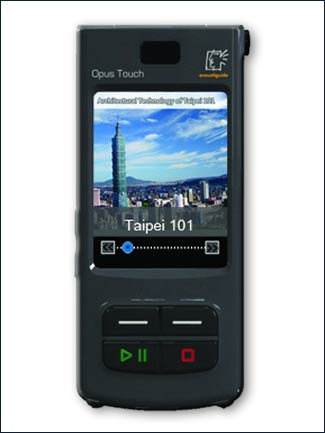By Avigayil Kadesh
If you’re visiting world-renowned sites such as the Louvre or Musée d'Orsay, the Guggenheim or Smithsonian, the Roman Baths or Westminster Abbey, Taipei 101 or the Israel Museum, you can get a multimedia guided tour via your own smartphone, MP3 player or tablet thanks to the Israeli company
Espro Acoustiguide Group.
Espro Acoustiguide provides traditional audio guides as well as web-based audio and multimedia tour apps in dozens of languages, with advanced features such as indoor and outdoor positioning and image recognition. The apps also offer animation, graphics, children tours, sign language tours and interactive games.
 Tour guide to Taipei’s 101 Tower in Taiwan
Tour guide to Taipei’s 101 Tower in Taiwan In September 2013, the company received worldwide press coverage -- including The Wall Street Journal's online magazine "Market Watch" -- for its new Acoustiguide Mobile solution for creating and distributing multilingual, visually rich multimedia tours on iOS and Android handsets and tablets.
The technology has come a long way since 1957, when US-based Acoustiguide introduced an audio tour of Hyde Park, the home of President Franklin D. Roosevelt. Narrated by his widow, Eleanor Roosevelt, the tour was given on the then state-of-the-art portable reel-to-reel player.
In 1993, the company unveiled the world's first digital wand player, at the Louvre in Paris. No longer did visitors have to follow a linear tour along a predetermined route. Now they could pick and choose the objects they wanted to learn about, and go at their own pace.
Today, you don’t even have to be on location to get a detailed tour of any of hundreds of museums and heritage sites on Espro Acoustiguide’s roster, because it’s all available digitally. You can use the app to acquaint yourself with the site before a visit or even in lieu of a visit.
The newest Espro Acoustiguide services are at the Solomon R. Guggenheim Museum in New York City and at the Tower of London.
The free
virtual Guggenheim tour features multimedia guides to current and past exhibitions and the museum’s entire permanent collection, as well as interviews with artists, curators and designers; and information about the Frank Lloyd Wright-designed building itself, including a detailed floor map.
The Children’s Tour launched last spring at the Tower of London is primarily based on multimedia, including narration by three ravens at the Tower with “appearances” from Henry VIII, Anne Boleyn, Richard II and Sir Walter Raleigh -- and on-screen images, quizzes and cartoons that keep young visitors engaged as their parents listen to the adult tour.
“It’s wonderful to see families listening to the tour together but also how the tour allows each visitor to get the most out of their own individual visit,” said a member of the Espro Acoustiguide Tower of London staff.
An audio and multimedia guide empire
It is quite common for overseas companies to buy Israeli startups, but the Kfar Saba-based firm has the opposite back story.
Espro Information Technologies, which had been honing its audio guide software since 1999, bought its well-established US-based competitor Acoustiguide in 2005. The combined entity placed in the Deloitte Israel Technology Fast 50 list in 2007, 2008 and 2009.
In 2010, Espro Acoustiguide acquired the Japanese company A&D AudioGuides, followed by the Canadian company Tristan Interactive in April 2013. Tristan became the New-Media Division of the Espro Acoustiguide Group.
This global group of companies – nine offices and a network of distributors from New York to Sydney and from Rio de Janeiro to St. Petersburg – is overseen by CEO Israel Gal, who cut his tech teeth in the Israel Defense Forces and then in Koor Industries. He joined Espro Information Technologies in its fifth year and brought it to new heights.
Gal acknowledges that the acquisition of a competitor by an Israeli company is unusual. Opportunity knocked when Acoustiguide had taken a tumble following a large investment in a new technology that failed. The much smaller Espro’s strength was technology and so it entered into a race to buy – and, in effect, rescue – the troubled Acoustiguide.
“It was a huge race and a huge risk at the time,” says Gal, who notes that acquiring a Japanese company was also rare for an Israeli firm. “But 18 months after acquisition, there was a huge turnaround reflected in the numbers.”
Espro’s French subsidiary worked with Tristan Interactive in 2012 to develop the Louvre’s official app, and its Australian office partnered with Tristan to launch an innovative app for the Museum of Contemporary Art Australia that orients visitors through indoor positioning technology.
When Espro Acoustiguide bought Tristan, it added Tristan’s own prestigious clients, such as the Guggenheim and four of the US government’s Smithsonian museums, to its burgeoning client roster.
“Our Israeli team now works shoulder to shoulder with our Canadian team to bring more advanced technologies,” says Gal.
“The basic platform is great for smartphones and tablets. The functionality until now is content and creating a warm, educational visitor experience. Now, with indoor positioning, we will enable users to know where they are precisely in very large, complex buildings. We’re working on this alongside other exciting capabilities like image recognition and augmented reality to enhance the borders of the visit.”
The client list keeps growing alongside technological advances that are in many cases exclusive.
“After three acquisitions and expansion, we are one of the world’s leading companies in mobile content for culture, art education and heritage,” says Gal.